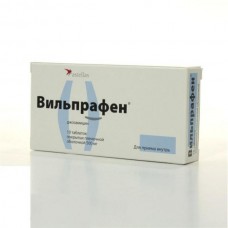Expiration dates: 03/2022
Structure and Composition: Film-coated tablets
1 tablet contains 500 or 1000 mg of josamycin
excipients: polysorbate 80 MCC precipitated silica, sodium carboxymethylcellulose, methylcellulose, magnesium stearate, talc, polyethylene glycol 6000 Titanium dioxide, aluminum hydroxide copolymer of methacrylic acid and its esters,
in blister 10 pcs. in one blister box.
Description pharmaceutical form:
Tablets white or almost white, oblong, biconvex, with risks on both sides.
Characteristic:
Antibiotic macrolide produced by Streptomyces narbonensis var. Josamyceticus.
Pharmacokinetics:
After oral josamycin rapidly and completely absorbed from the gastrointestinal tract, food intake does not affect the bioavailability. Serum Cmax achieved in 1-2 hours after administration. About 15% of josamycin bound to plasma proteins. Particularly high concentration of a substance found in the lungs, tonsils, saliva, sweat and lacrimal fluid. sputum concentration than the plasma concentration of 8-9 times. It accumulates in bone tissue. Passes placental barrier, is secreted into breast milk. Josamycin metabolized in the liver to less active metabolites and excreted primarily in the bile. Excretion of the drug in the urine - less than 20%.
Description of the pharmacological actions:
It inhibits bacterial protein synthesis. When creating a high concentration of inflammatory hearth has a bactericidal effect.
The drug is used to treat bacterial infections bacteriostatic activity of josamycin, like other macrolides, due to inhibition of protein synthesis of bacteria. When creating a high concentration of inflammatory hearth has a bactericidal effect.
Josamycin highly active against intracellular bacteria (Chlamydia trachomatis and Chlamydia pneumoniae, Mycoplasma pneumoniae, Mycoplasma hominis, Ureaplasma urealyticum, Legionella pneumophila) Gram-positive bacteria (Staphylococcus aureus, Streptococcus pyogenes and Streptococcus pneumoniae (pneumococcus), Corynebacterium diphtheriae), Gram-negative bacteria (Neisseria meningitidis , Neisseria gonorrhoeae, Haemophilus influenzae, Bordetella pertussis), as well as against some anaerobic bacteria (Peptococcus, Peptostreptococcus, Clostridium perfringens). Slightly affects the enterobacteria, so little change natural bacterial flora of the gastrointestinal tract. Effective for resistance to erythromycin. Josamycin resistance develops less often than to other antibiotics of the macrolide group.
Testimony:
Acute and chronic infections caused by microorganisms sensitive to the drug:
- infections of the upper respiratory tract and ENT-organs (tonsillitis, pharyngitis, paratonsillitis, laryngitis, otitis media, sinusitis, diphtheria (in addition to the treatment of diphtheria toxoid), and scarlet fever in the case of hypersensitivity to penicillin)
- lower respiratory tract infections (acute bronchitis, exacerbation of chronic bronchitis, pneumonia (including caused by atypical pathogens), whooping cough, psittacosis)
- dental infections (gingivitis and periodontal disease)
- infections in ophthalmology (blepharitis, dacryocystitis)
- infections of skin and soft tissue (pyoderma, furunculosis, anthrax, erysipelas (in case of hypersensitivity to penicillin), acne, lymphangitis, lymphadenitis, lymphogranuloma venereum
- infections of the genitourinary system (prostatitis, urethritis, gonorrhea, syphilis (in case of hypersensitivity to penicillin), chlamydial, mycoplasma (including ureaplazmennogo) and mixed infections.
Contraindications:
- hypersensitivity to macrolide antibiotics,
- severe liver dysfunction.
Application of pregnancy and breastfeeding:
Permitted use during pregnancy and breastfeeding period indicated. The European branch of the WHO recommends josamycin as the drug of choice for treatment of chlamydial infection in pregnant women.
Side effect:
From the digestive tract: rare - loss of appetite, nausea, heartburn, vomiting, goiter, diarrhea. In the case of persistent severe diarrhea should be borne in mind the possibility of the development against the backdrop of antibiotics life-threatening pseudomembranous colitis.
Hypersensitivity Reactions: In extremely rare cases, possible allergic skin reactions (eg urticaria).
On the part of the liver and biliary tract: in some cases there was a transient increase in liver enzymes in the blood plasma, in rare cases followed by violation of the outflow of bile and jaundice.
On the part of the hearing system: in rare cases reported transient dose-related hearing impairment.
Other: very rarely - Candida.
Drug Interactions:
Other antibiotics. If necessary, the simultaneous use with other antibiotics should be kept in mind that the bacteriostatic bactericidal antibiotics can reduce the effect of other antibiotics such as penicillins and cephalosporins, so avoid concomitant administration josamycin data types of antibiotics. Josamycin should not be used in conjunction with lincomycin, because possible mutual loss of efficiency.
Xanthines. When using both the macrolide-antibiotics xanthines with found that some members of the macrolide-antibiotics slow elimination xanthines (theophylline), which can lead to intoxication. Clinical and experimental studies indicate that josamycin has less effect on the allocation of theophylline than other antibiotics, macrolides.
Antihistamines. After concomitant administration of antihistamines and josamycin containing terfenadine or astemizole, there may be a slowing excretion of terfenadine and astemizole, in turn, can lead to life-threatening cardiac arrhythmias.
Ergot alkaloids. After the joint appointment of ergot alkaloids and macrolide antibiotics, there are isolated reports of strengthening vasoconstriction. Therefore, concomitant use of ergotamine josamycin and must be accompanied by appropriate control patients.
Cyclosporin. Co-administration of josamycin and cyclosporine may cause increased cyclosporine levels in blood plasma and the creation of nephrotoxic concentration of cyclosporine in the blood. You should regularly monitor the concentration of cyclosporine in plasma.
Digoxin. The joint appointment josamycin and digoxin may increase the level of the latter in the blood plasma.
Hormonal contraceptives. In rare cases, the contraceptive effect of hormonal contraceptives may be insufficient during treatment with antibiotics, macrolides. In this case, it is recommended to use an additional non-hormonal contraception.
Dosage and administration:
Inside, swallowing whole with a little water.
The recommended daily dosage for adults and adolescents aged over 14 years - from 1 to 2 g daily dose should be divided into 2-3 doses. The initial recommended dose - 1 g
In the case of common acne and globular - 500 mg 2 times a day for the first 2-4 weeks, then - 500 mg 1 time per day as a maintenance treatment for 8 weeks.
Typically, the duration of treatment is determined by the doctor. In accordance with WHO recommendations on the use of antibiotics duration of treatment of streptococcal infections should be at least 10 days.
Overdose:
Symptoms: increased side effects, especially on the part of the digestive tract (the specific symptoms of poisoning do not have data).
Precautionary measures:
Precautions should be prescribed in patients with renal insufficiency.
Special instructions:
If you omit a time, you must immediately take the dose, but if it's time for your next dose, should be back to normal treatment. Do not take double the dose. A break in the treatment or premature discontinuation of the drug reduces the chance of treatment success.
In patients with renal insufficiency treatment should be carried out taking into account the results of relevant laboratory tests.
Consideration should be given an opportunity to cross-resistance to various antibiotics, macrolides (e.g. microorganisms resistant to treatment by antibiotics related in chemical structure may also be resistant to josamycin).



